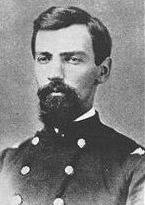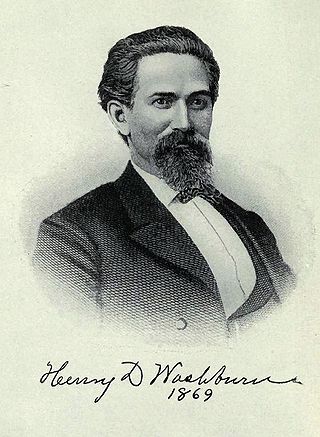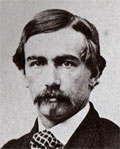
XXII Corps was a corps in the Union Army during the American Civil War. It was created on February 2, 1863, to consist of all troops garrisoned in Washington, D.C., and included three infantry divisions and one of cavalry. Many of its units were transferred to the Army of the Potomac during Grant's Overland Campaign.

The African American Civil War Memorial Museum, in the U Street district of Washington, D.C., recognizes the contributions of the 209,145 members of the United States Colored Troops (USCT). The eponymous memorial, dedicated in July 1998 by the African American Civil War Memorial Freedom Foundation, commemorates the service of 209,145 African-American soldiers and about 7,000 white and 2,145 Hispanic soldiers, together with the approximate 20,000 unsegregated Navy sailors, who fought for the Union in the American Civil War, mostly among the 175 regiments of United States Colored Troops.

William W. Wells, Jr. was a businessman, politician, and general in the Union Army during the American Civil War who received a Medal of Honor for gallantry at the Battle of Gettysburg.

Rufus R. Dawes was a military officer in the Union Army during the American Civil War. He used the middle initial "R" but had no middle name. He was noted for his service in the famed Iron Brigade, particularly during the Battle of Gettysburg. He was a post-war businessman, Congressman, and author, and the father of four nationally known sons, one of whom, Charles G. Dawes, won the Nobel Peace Prize and served as Vice President of the United States, and of two daughters. He was himself a great-grandson of William Dawes, who alerted colonial minutemen of the approach of the British Army prior to the Battles of Lexington and Concord at the outset of the American Revolution, and a maternal great-grandson of the Rev. Manasseh Cutler, who was instrumental in adoption of the Northwest ordinance of 1787, led the formation of the Ohio Company of Associates, and became "Father of Ohio University".

Asa Peabody Blunt was an officer in the Union Army during the American Civil War. He remained on active duty after the war. In recognition of his service during the Civil War, he was appointed to the grade of brevet brigadier general of volunteers. Blunt was notable as commander of the 2nd Vermont Brigade and the United States Disciplinary Barracks at Fort Leavenworth, Kansas.

The 6th Wisconsin Infantry Regiment was an infantry regiment that served in the Union Army during the American Civil War. It spent most of the war as a part of the famous Iron Brigade in the Army of the Potomac.

Benjamin Caspar Christ was an officer in the Union army during the American Civil War. He commanded a brigade in the IX Corps of the Army of the Potomac at several important battles, including the Battle of Antietam.

Henry Dana Washburn was a U.S. Representative from Indiana and a colonel and was breveted twice as brigadier general and major general in the Union Army during the American Civil War.

Samuel Sprigg "Red" Carroll was a career officer in the United States Army who rose to the rank of brigadier general of the Union during the American Civil War. The Maryland native was most known for his service as the commander of the famed "Gibraltar Brigade", an infantry brigade in the Army of the Potomac that played a key role in the defense of Cemetery Hill during the Battle of Gettysburg, as well as in repulsing a portion of Pickett's Charge.
The "Gibraltar Brigade" was a famed infantry brigade within the Army of the Potomac during the American Civil War. Recognizing its tenacity in combat at the Battle of Antietam, Brigadier General William French assigned the nickname as a comparison to the steadfastness of the Rock of Gibraltar. At Antietam the 8th Ohio Infantry, 14th Indiana Infantry, 7th West Virginia Infantry and 132nd Pennsylvania comprised the Brigade. The 4th Ohio Infantry Regiment was forced to miss the Maryland Campaign due to regiment-wide sickness but was otherwise a consistent member of the Brigade. It served in many of the major battles of the Eastern Theater.

Walter P. Phelps Jr. was an officer in the Union Army throughout the American Civil War, serving as commanding officer of the Eastern Iron Brigade.

Thomas Worcester Hyde was an American Union Army colonel, a state senator from Maine, and the founder of the Bath Iron Works, one of the major shipyards in the United States. He wrote two books about his experiences during the American Civil War and at the Battle of Gettysburg.

William Stowell Tilton was an American businessman and soldier who led a regiment, and occasionally a brigade, in the Army of the Potomac during the American Civil War. He and his men were heavily engaged in the Battle of Gettysburg, where Tilton's performance created controversy.

Charles Sawyer Russell was a United States Army officer in the Union Army during the American Civil War.

John E. Bendix was an officer in the Union Army during the American Civil War who commanded two different New York regiments and then a brigade of infantry in Army of the Potomac in the Eastern Theater. He survived a serious wound at the Battle of Fredericksburg in December 1862. He was noted as a prolific recruiter and organizer, and after the war, as a brevet general in the New York Militia, he helped organize the reconstruction era the New York state militia that later became the New York Guard. Bendix was mustered out of the Union Army on May 7, 1863. In July 1866, he was nominated and confirmed for appointment to the grade of brevet brigadier general of volunteers, to rank from March 13, 1865.

Sumner Carruth was an officer in the volunteer army of the United States during the American Civil War. He commanded the 35th Massachusetts Volunteer Infantry and eventually rose to the command of two different brigades in the IX Corps.

Charles Swain Lovell (1811-1871) was an American military officer and Brevet Brigadier General who commanded a brigade during several major battles of the American Civil War.

Joseph Henry Barnes (1833-1906) was an American Brevet Brigadier General who commanded the 29th Massachusetts Infantry Regiment during the Eastern Theater of the American Civil War.

John Worthington Ames (1833-1878) was an American Brevet Brigadier General and engineer who participated in the American Civil War. He commanded the 6th United States Colored Infantry Regiment throughout the war, previously being within the 11th Infantry Regiment.

The 8th Louisiana Infantry Regiment was a unit of volunteers recruited in Louisiana that fought in the Confederate States Army during the American Civil War. Formed in June 1861, the regiment was sent to fight in the Eastern Theater of the American Civil War. Joining a brigade of Louisiana regiments, it fought in Jackson's Valley campaign and at Gaines' Mill, Malvern Hill, Second Bull Run, Antietam, and Fredericksburg in 1862. The regiment served at Chancellorsville, Second Winchester, Gettysburg in 1863. At Rappahannock Station in November 1863, most of the regiment was captured. The unit fought at the Wilderness, Spotsylvania, Cold Harbor, and the Valley campaigns of 1864. It served at Petersburg starting in December 1864 and surrendered at Appomattox in April 1865.



















